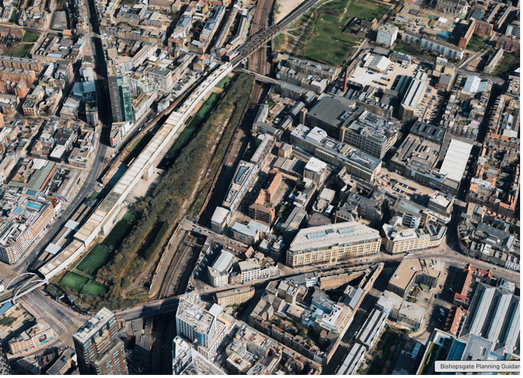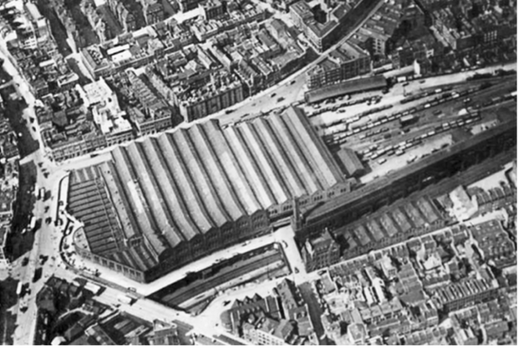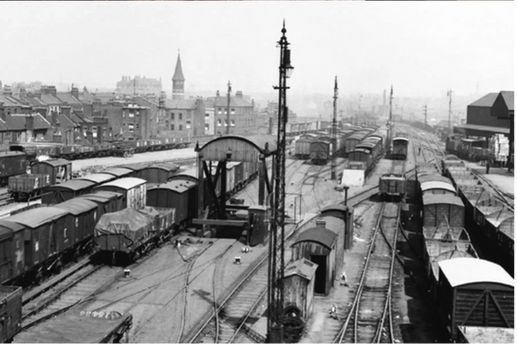Bishopsgate Goodsyard: Where the buddleia reigns…for now
- Lee Mallett

- May 20
- 4 min read

“East is best, the West is the rest” was a saying in Shoreditch’s artist-led renaissance back in the 1990s, affirmation that a new place was emerging. We’re talking pre-Tea Building and way before Shoreditch House opened in 2007 - when nearly all buildings in Hoxton Square were vacant. Times were tough and interest rates went over 10%, remember that?
Shoreditch was fun – rapidly filling with “cultural migrants” – young people from elsewhere finding a place in the capital, a deserted canvas with affordable spaces for uneconomic, experimental activity. Most of the artists who moved in then have sold up and moved out, especially the YBAs who made it big. Now the coast is clear for developers to complete the job, times are tough again, but may be improving.
Last June CAF visited Norton Folgate, now complete. In February we toured the nascent Truman Brewery development. And this month we visited the 4.5 hectare Bishopsgate Goodsyard, the largest of central London’s unregenerated sites.
The tour was led by CAF member and local architect Chris Dyson and Hammerson’s development manager Tony Coughlan. Chris is working on the Goodsyard’s proposed new cultural building and retained buildings including a mission hall and Huguenot weavers’ houses on Sclater Street.
Put Norton Folgate, Truman and the Goodsyard together, amid all the development round about, and perhaps it is time to think about what this transborder patch, once disparagingly referred to as “The
City Fringe”, might eventually become.
Three sites that will transform the trans-borough “City fringe (with Norton Folgate in red at centre left)
Techies and affluent others have taken over Shoreditch and much of the City, reinventing banking and everything else. The Revenge of the Nerds is driving demand and increasing rents which will recast and reinvent much of the area, perhaps stretching from Farringdon in the west to beyond Brick Lane and up to London Fields and even unto Mare Street in Hackney.
London is doing what it always has – reinventing itself, making new economies and remaking its places to suit.
It begs the questions of how long and how far will this effect travel, and should you be building offices or homes to optimise cash flow? Hackney for one has been keen to see major offices on the business end of the site. Some local groups expressed a different view.
For most Londoners the lower and upper worlds of Bishopsgate Goodsyard have been forbidden since 1964 when a fire wrecked station, depot and elevated goodsyard. The 1840 Victorian complex closed and became a forgotten citadel.
Members walked up the steep cobbled ramp overlooking the mainline rail cutting running into Liverpool Street and over Bishopsgate, having emerged from the vast underbelly of the Goodsyard’s arches onto the “railway field” as it was called. This was where produce and goods arrived from East Anglia for sale before being distributed to Spitalfields vegetable market. Now the “developer’s friend” - wild buddleia reigns supreme, while surrounding new towers loom over.
A start date for Hammerson and Ballymore’s main construction works mooted last year has now become “possibly” later this year, planning approval for the reserved matters application having been won for Building 1 (Gensler and Buckley Gray Yeoman) in November 2024 from Hackney and Tower Hamlets.
Any hesitancy about pushing the button on this “Saturn 5” rocket of a scheme – up to 500 homes, 1.4m sq ft of offices, a 2.6 acre park, restaurants, retail and leisure, plus two culture spaces and a ten year delivery plan - in current circumstances is understandable. Ballymore and Hammerson are probably hoping a pre-let might turn up for one of the three major office buildings proposed for the western end of the schem1.4. And they might get lucky as the workspace market in the City and surrounds is looking increasingly healthy.
Two phases are likely to commence to start with, one office plot and either one residential plot or the cultural building, designed by Chris Dyson Architects, along with some retail space, depending on how the market for these uses evolves in coming months. Four phases overall is current thinking.
The Goodsyard will be one of the more unusual and intriguing schemes in London when built, as FaulknerBrowns’ masterplan shows. The scheme’s east-west linear “striations” dictated by the long site plan and retained Victorian infrastructure generating large differences in levels, and its “razor back” built form, quickly diminishing in height from Bishopsgate to Brick Lane in the east give it a unique form and a complex connectivity, especially from north to south across the level changes.
A total of c. six acres of public realm is included. What will the elevated public green spaces, designed by Spacehub, feel like and how will the developers manage to fill and make attractive all of the large conserved arches underneath?
Will a cohesive community composed of residents, with 50% of the c.500 homes being affordable, and employees working in the 1.4m sq ft of offices be formed, and will the scheme integrate with its rapidly morphing surrounds – a key goal of the masterplan.
The growing shortage of major buildings to let in the City is surely a good omen that six decades of waiting for The Goodsyard’s second coming is nearly over and answers to those questions will soon be arriving at the former station.





















Comments